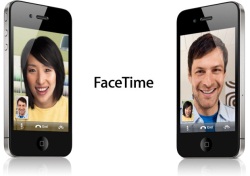Last month, open Internet advocacy groups threatened to file complaint against AT&T with the Federal Communications Commission due to AT&T’s decision to limit the use of Apple’s FaceTime video calling application. AT&T said that users wouldn’t be able to use FaceTime over its cellular network, unless they were also on the carrier’s Mobile Share Plans. Well, good news, folks: AT&T has decided to expand FaceTime access.
No, no, it’s still not available to everyone. Sorry. I mean, it’s AT&T, right? Instead, today’s announced changes will only affect iPhone 5 and iPad users. On devices which support LTE connections. On tiered data plans. Yes, the new tiered data plans – not that unlimited data plan some iPhone early adopters are grandfathered into. You know, AT&T’s most loyal iPhone users? The ones who didn’t jump to the Verizon iPhone when it became available? No FaceTime for you! (Except on Wi-Fi, as per usual.)
AT&T announced the expanded options on its Public Policy blog today, including some thoughts penned by Jim Cicconi, AT&T’s head of External and Legislative Affairs. Again, he puts forward the case that because FaceTime is a pre-loaded application on Apple’s devices, it can’t determine the impact it would have on AT&T’s network:
In this instance, with the FaceTime app already preloaded on tens of millions of AT&T customers’ iPhones, there was no way for our engineers to effectively model usage, and thus to assess network impact. It is for this reason that we took a more cautious approach toward the app. To do otherwise might have risked an adverse impact on the services our customers expect – voice quality in particular – if usage of FaceTime exceeded expectations. And this is important for all our customers regardless of which smartphone they may use.
It’s not an incorrect statement, just a really, really unpopular one. FaceTime would likely eat up network infrastructure and bandwidth, which could degrade service on AT&T’s network. It’s hard to say by how much, but that’s the point that AT&T is making here – it’s not sure. Hence this so-called “cautious approach.” (Not entirely coincidentally, AT&T announced this week it would invest $14 billion in infrastructure upgrades, $8 billion of which are for wireless upgrades. Part of those efforts are to expand LTE access to 300 million by 2014.)
But while limiting the access on the one hand could be framed as a “necessary evil,” the decision to restrict it to a particular type of data plan (Mobile Shared), seemed like way to force users into the new, and more expensive, data plans. Concerns were rightfully raised. Today’s announcement improves the situation, but doesn’t solve it. Now tiered data plans and Shared plans are allowed to use FaceTime. Unlimited users, not so much. But surely AT&T hopes this is another way to get a few of them to give up and switch.
However, AT&T addressed the other issue about its FaceTime restrictions today, it’s worth noting. Before, the restrictions meant limited access for deaf users or hard-of-hearing customers, who use visual calling instead of voice calling in order to sign instead of talk. AT&T says that now, those who qualify for special text and data-only packages will now also have access to FaceTime. These customers had access to new billing plans on October 26.
For the rest of AT&T’s users, the added FaceTime support will roll out over the next 8-10 weeks.
AT&T’s full blog post below:
As most observers are aware, Apple’s FaceTime application is currently enabled on AT&T’s popular Mobile Share plan as well as on Wi-Fi, though not at this time on our other billing plans. This approach has raised questions and some concerns. We decided to take this cautious approach for important reasons. AT&T has by far more iPhones on our network than any other carrier. We’re proud of this fact and the confidence our customers have in us. But it also means that when Apple rolls out new services or changes, as it did in iOS 6, it can have a much greater, and more immediate, impact on AT&T’s network than is the case with carriers who have far fewer iPhone users.
In this instance, with the FaceTime app already preloaded on tens of millions of AT&T customers’ iPhones, there was no way for our engineers to effectively model usage, and thus to assess network impact. It is for this reason that we took a more cautious approach toward the app. To do otherwise might have risked an adverse impact on the services our customers expect – voice quality in particular – if usage of FaceTime exceeded expectations. And this is important for all our customers regardless of which smartphone they may use.
In the meantime, we are announcing today that we will support FaceTime, not only on our Mobile Share plans, but also on all of our tiered data plans with an LTE device. We expect to roll out this functionality over the next 8-10 weeks. In addition, we are informing our deaf and hard of hearing customers that, as of October 26, we began rolling out several new billing plans designed to allow them to make use of FaceTime. This is part of our ongoing commitment to our customers with disabilities, and it’s a commitment which is very important to us.
We will continue to gather and assess the network data on this issue over the next few months and anticipate that we will be able to expand the availability of FaceTime to our customers on other billing plans in the near future.
